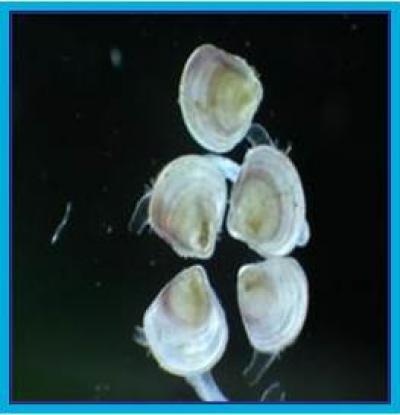Four of the most common mosquito pesticides used along the east and Gulf coasts show little risk to juvenile hard clams and oysters, according to a NOAA study in Archives of Environmental Contamination and Toxicology.
The paper also determined that lower oxygen levels in the water, known as hypoxia, and increased acidification increased how toxic some of the pesticides were. Such climate variables should be considered when using these pesticides in the coastal zone, the study concluded.
"What we found is that larval oysters and hard clams can withstand low levels of pesticide use, but they are more sensitive to pesticides if their ecosystem is suffering from local climate stressors like hypoxia and acidification," said the study's lead author, Marie DeLorenzo, Ph.D., NOAA environmental physiology and microbiology program lead with NOAA's Centers for Coastal Ocean Science. "Hopefully these data will benefit both shellfish mariculture operations and environmental resource agencies as they manage the use of mosquito control pesticides near their coastal ecosystems."
Commercial shellfishing has a large economic national impact. NOAA Fisheries estimated that U.S. oyster and hard clam landings for 2010 were worth nearly $118 million and $41 million, respectively. Shellfish growers, however, are concerned that pesticide spraying near the coastlines may contaminate both their hatcheries and source waters. This is compounded by a lack of data on the toxicity of mosquito insecticides for these shellfish.
These ecologically and economically important species inhabit tidal marsh habitats along the U.S. Atlantic and Gulf of Mexico coastlines. Clams and oysters are also important for the coastal ecosystem because they filter water, improving water quality, and serve as habitat and food sources for other estuarine species.

The study showed low risk of impacts from four common mosquito pesticides on juvenile hard clams -- but that risk increased with climate stressors such as hypoxia. Credit: NOAA
Approximately 200 mosquito species live in the United States. In addition to causing painful itchy bumps to people, mosquito bites can transmit serious diseases such as malaria, dengue fever, and West Nile virus. One approach to controlling mosquitoes is to apply pesticides by spraying from planes or trucks over a large area. However, to effectively control mosquitoes, the pesticides must target species which live in aquatic habitats that are also home to sensitive estuarine species. This may pose a risk to coastal environments. Also, since many residential communities where the pesticides may be used are near these coastal aquatic habitats, the potential for direct overspray or unintentional drift into these waters is increased.
The study sought to address a lack of toxicity data for mosquito control pesticide effects on shellfish early life stages. The research team examined the toxicity of four mosquito control pesticides (naled, resmethrin, permethrin, and methoprene) to larval and juvenile life stages of hard clams (Mercenaria mercenaria) and Eastern oysters (Crassostrea virginica).
Lethal thresholds were determined for the four pesticides, and differences in sensitivity were found between chemicals, species, and life stages tested. Overall, clams were more susceptible to mosquito control pesticides than oysters. Naled, an organophosphate chemical, was the most toxic compound in oyster larvae, while resmethrin was the most toxic compound in clam larvae. Decreased swimming activity was observed after four days in larval oysters and decreased growth was found in juvenile clams and oysters after 21 days.
Using a hazard assessment, which compared the toxicity thresholds to concentrations expected in the environment, the researchers calculated a low-level of risk to clams and oysters from application of these pesticides for mosquito control.
The researchers also tested the pesticides' toxicity under climate stress conditions. The more extreme climate conditions caused increased pesticide toxicity.
The study did not evaluate any impact of the pesticides on other shellfish such as shrimp or lobsters.




Comments